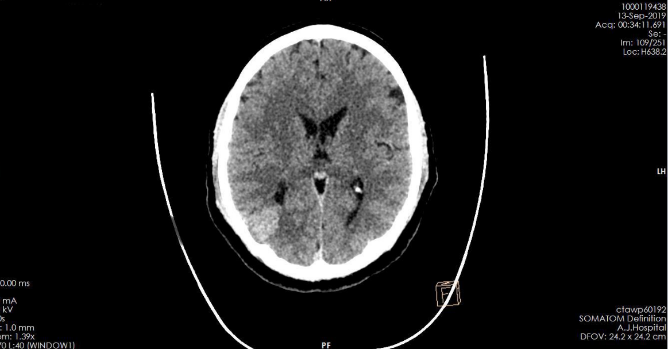Introduction
Guillain-Barre syndrome (GBS) is an acute polyneuropathy and is the most common cause of acute flaccid paralysis, with a global incidence of approximately 1-2 per 100,000 person-years.1 Up to 20% of patients remain severely disabled and approximately 5% die,despite immunotherapy.2 GBS has a varied aetiology, mostly preceded by upper respiratory tract infection or diarrhoea. Our review of literature indicates that GBS following snake bite is rarely reported. Here is a report of a patient of snake envenomation who presented with neuromuscular and haematological complications comprising of cerebral bleed, quadriparesis and respiratory failure and later developed severe peripheral neuropathy due to GBS.
Case Presentation
A 24-year-old male patient with alleged history of snake bite was awake, oriented but had bilateral ptosis, ocular muscle palsy, and weakness of all four limbs with intact deep tendon reflexes on arrival. Fang marks were noticed on his right lower leg. On admission, he developed seizures which were controlled with antiepileptic drugs. His bleeding parameters were prolonged. Patient was managed aggressively with 35 vials of ASV (anti snake venom) and was put on mechanical ventilation in view of his poor respiratory effort on the day of arrival. On day two, a CT scan of the brain done showed right parieto-temporal bleed (Photo of the ct scan attached). CT scan repeated the next day did not show an increase in the bleed. In the ensuing period, ptosis improved but quadriparesis persisted and respiratory failure did not improve and hence, a tracheostomy tube was placed. Twelve days after admission, the patient developed generalised areflexia. Nerve conduction studies done showed severe sensory-motor axonal neuropathy of upper and lower limbs.(NCS findings attached). There was no history of recent respiratory or gastrointestinal infections. CSF study was normal, suggesting AMSAN variety of GBS. The patient was treated with 2gram/kg of intravenous immunoglobulins over 5 days. Patient’s motor power improved, and he was weaned from the ventilator. At the time of discharge, patient was able to walk with support. He had grade 5 power during follow up.
Discussion
GBS has a varied aetiology. Two-thirds of the cases are all preceded by symptoms of upper respiratory tract infection or diarrhoea. 30% of infections were attributed to C. Jejuni in one meta-analysis, whereas Cytomegalovirus has been identified in up to 10%. Other infectious agents with a well-defined relationship to the Guillain-Barre syndrome are Epstein– Barr virus, Varicella–zoster virus, and Mycoplasma pneumoniae.3 Newton and Janati have also reported a case of GBS that developed after the injection of pure tetanus toxoid. 4
There are only a few published cases of GBS following snake bites. Immune reaction to snake venom, anti-snake venom, or tetanus toxoid injections might be one reason for the development of GBS. GBS following snake bite was first reported four weeks after a Formossan krait bite (Bungarus multicinctus by Chuang et al. in 1996,5 the second case by Srivastava et al. in 2010 following an unknown snake bite, 6 and the third case by Neil et al. where a patient developed GBS following the bite of the snake Vipera aspis. 7 The authors demonstrated cross reactivity between venom proteins and the neuronal GM2 gangliosides (molecular mimicry) by western blot assay. They showed that the patient’s serum presented specific cross-reactions with several glycosylated venom proteins proving an immunological basis rather than a direct toxicity of the venom.
In 2014, Neto et al. from Brazil reported the fourth case of GBS two weeks following a rattle snake bite (Crotalus sp.).8 Here, the patient developed sensory motor axonal poly-radiculo-neuropathy. In 2017, Kanni et al. reported the fifth case, where a nerve conduction study showed sensory motor demyelinating polyneuropathy.9 The sixth case was reported in 2018 by Velu in a child who developed axonal motor sensory type of GBS, 2 weeks after a Krait bite. 10 The seventh case was reported by Hameed S et al. in 2019, where a fisherman developed AMAN variant of GBS, 3 weeks after the bite of a yellow-bellied sea snake (Hydrophisplaturus). 11
Of all the seven cases described in the literature, five are males, one case was 11 year old girl, and in one of the cases gender was not mentioned. Oldest case was 62 year male, and the youngest was 11 year old. The occurrence of GBS following snake bite was correlated with male gender. However there was no correlation with age.
To the best of our knowledge, ours is the eighth case ever to be reported. We believe given the vast number of snake bite cases around the world, GBS following snake bite is not uncommon but is in fact underreported.
Conclusion
As more cases of GBS following snake bite get reported, the association of snake bite with GBS may not actually be uncommon but may be an under-reported entity. We recommend that the development of progressive weakness due to GBS be actively looked for in patients of snake bite. A correct and timely identification of this entity will lead to better patient outcomes.

